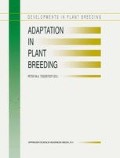Summary
Compared were the number of mitochondria and chloroplasts in the chlorenchyma cells of pine needles (Pinus sylvestris), birch leaves (Betula pubescens), and shrub leaves (Arctostaphylos uva-ursi, Vaccinium vitis-idaea, V. myrtillus, V. uliginosum). Included also were herbaceous plant leaves Campanula rotundifolia, Cornus suecica, Potentilla erecta and Solidago lapponica. These plants were growing 10 km (severely polluted area) and 65 km (background area) south (SSW) of the ‘Severonickel’ smelter complex (Monchegorsk, Kola peninsula), where the dominating gaseous atmospheric pollutant is SO2. Comparison between plants of polluted and unpolluted areas was made using electron microscopy on intact chlorenchyma cells. Morphometric analysis showed that the chloroplast numbers in the mesophyll cells did not depend on the pollution level. The mitochondria numbers did not differ significantly in leaf cells of the deciduous and herbaceous plants. However, it is considerably higher in evergreen species of the damaged area. The conclusion is that the increase of the mitochondria numbers is the adaptative response of the evergreen plants to atmospheric pollution.
Access this chapter
Tax calculation will be finalised at checkout
Purchases are for personal use only
Preview
Unable to display preview. Download preview PDF.
References
Alexandrov, V.J., 1985. Cell Reactivity and Proteins, 317 pp. Nauka, Leningrad (in Russian).
Boltneva, L.1., A.A. Ignatyev, R.T. Karaban, I.M. Nazarov and T.I. Sisigina, 1982. Forecast model of vegetation injury by atmospheric industrial emissions. Interaction between forest ecosystems and pollutants. Tallinn. Part II: 163–173 (in Russian).
Bubolo, L.S., 1984. A comparative ultrastructural analysis of the leaf chlorenchyma cells in some representatives of the Wrangel Island and Leningrad region floras. Russ J Bot J 69: 1482–1491.
Furukawa, A., T. Natory and T. Totsuka, 1980. The effect of SO2 on net photosynthesis in sunflower leaf. Studies on the effect of air pollutants on plants and mechanisms of phytotoxicity. Res Rep Natl Inst Environ Stud Japan 11: 1–8.
Hochachka, P.W. and G.N. Somero, 1977. Biochemical Adaptation. 568 pp. Princeton University Press, Princeton, New Jersey.
Ivanova, T.I., O.S. Judina and O.A. Semikhatova, 1992. About the adaptive component of respiration. Gas exchange in agricultural and natural plant phytocenoses. Syktyvkar. p. 28 (in Russian).
Ivanova, T.I., O.A. Semikhatova, O.S. Judina and G.D. Leina, 1989. The effect temperature on the respiration of plants from different zones. In: O.A. Semikhatova (Ed.), Ecophysiological Investigations of Plant Photosynthesis and Respiration, pp. 140–167. Nauka, Leningrad (in Russian).
Kaibiyainen, L.K., P. Hari, G.I. Sofronova and V.K. Bolondinskii, 1994. CO2 exchange in vivo: test for plant conditions as affected by persistent toxic pollutants. Plant Physiol 41 (5): 788–793.
Kravkina, I.M., E.A. Miroslavov and R.E. Crang, 1989. The impact of sulphur dioxide fumigation on photosynthetic and ultrastructural responses of mesophyll cells from developing Pinus strobus needles. I. Mesophyll cells. Proceedings of the second US-USSR symposium on: Air pollution effects on vegetation including forest ecosystems, pp. 71–81. North Forest Exp Station.
Kropff, M.J., 1990. The effect of long-term open-air fumigation with SO2 on a field crop of broad-bean (Vicia faba L.). III. Quantitative analysis of damage components. New Phytol 115 (2): 357–365.
Kryuchkov, V.V. and T.D. Makarova, 1989. Aerotechnogenic impact on the ecosystems of Kola North. Apatity. 96 pp. (in Russian).
Malhotra, S.S. and A.A. Khan, 1988. Biochemical and physiological effect of the priority pollution substances. In: M. Treshow (Ed.), Ear Pollution and Plant Life, pp. 144–189. Leningrad. 535 pp. (in Russian).
Miroslavov, E.A. and L.S. Bubolo, 1980. The ultrastructure of the cells of the leaf chlorenchyma in some arctic plants. Russ J Bot J 65 (11): 1523–1530.
Miroslavov, E.A. and I.M. Kravkina, 1991. Comparative analysis of chloroplasts and mitochondria in leaf chlorenchyma from mountain plants grown at different altitudes. Ann Bot 68: 195–200.
Miroslavov, E.A., I.M. Kravkina and L.S. Bubolo, 1990. The structural adaptation of the plastidom and chondriom to the conditions of high-mountain and far North. Russ J Ecology 4: 36–42.
Pozniakov, V.Ya., 1993. The `Severonickel’ smelter complex: history of development. Aerial pollution in Kola Peninsula (April 14–16, 1992, St.-Petersburg): Proc of the Intern Workshop. St.-Petersburg; Apatity. pp. 16–19.
Semikhatova, O.A., 1990. Energy aspects of plant respiration under normal conditions and ecological stress. The 48th Timiryazev Lecture. Nauka, Leningrad. 73 pp.
Semikhatova, O.A., 1995. Maintenance respiration and the cost of plant adaptation. Russ J Plant Physiol 42 (2): 312–319.
Soikkeli, S., 1981. Comparison of cytological injuries in conifer needles from several polluted industrial environments in Finland. Ann Bot Fenn 18 (1): 47–61.
Soikkeli, S. and T. Tuovinen, 1979. Damage in mesophyll ultrastructure of needles of Norway spruce. Ann Bot Fenn 16 (1): 50–64.
Yarmishko, V.T., N.M. Deyeva, E.A. Maznaya and G.D. Leina, 1995. Impact of industrial emissions on assimilation apparatus of Pinus sylvestris L. and Vaccinium myrtillus L. of the European north of Russia. Russ J Plant Res 3: 36–51.
Author information
Authors and Affiliations
Editor information
Editors and Affiliations
Rights and permissions
Copyright information
© 1997 Springer Science+Business Media Dordrecht
About this chapter
Cite this chapter
Kravkina, I.M. (1997). Structural adaptation of the leaf chlorenchyma to stress condition in the Kola peninsula plants. In: Tigerstedt, P.M.A. (eds) Adaptation in Plant Breeding. Developments in Plant Breeding, vol 4. Springer, Dordrecht. https://doi.org/10.1007/978-94-015-8806-5_23
Download citation
DOI: https://doi.org/10.1007/978-94-015-8806-5_23
Publisher Name: Springer, Dordrecht
Print ISBN: 978-90-481-4708-3
Online ISBN: 978-94-015-8806-5
eBook Packages: Springer Book Archive

